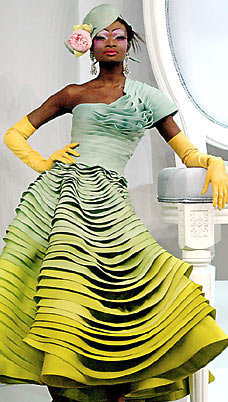He was the first designer to understand the importance of designing accessories and putting his name to a scent, and consequently his business made a 900 per cent return in three years.
Seven years after he opened his doors on the Avenue Montaigne, he grossed £7 million annually, accounting for over half of all Parisienne couture exports. He was a business wizard.
He came up with the modern concepts of licensing and advertising, and branched out into bags, gloves, men's ties and costume jewellery.
He was a dab hand, too, at publicity and clever marketing. He once said: "Gossip, even malicious rumours, are worth more than the most expensive publicity campaign in the world."
Famous women, including Olivia de Havilland, Vivien Leigh, Princess Margaret, Grace Kelly and even Eva Peron were photographed in his designs.
He worked mostly with wool, which was fine for Britain and France, but in America, with its new fangled central heating, his clothes were too hot (Dior was the first to design sleeveless tweed dresses for day, and to line a Mackintosh with mink), and so he would refine the weight of the cloth according to climate.
Dior went from strength to strength. In the Fifties came the A-line and the Y-line and the H-line (which many thought unflatteringly flat-chested), and while the silhouette evolved, his greatest gift emerged: he ensured that every woman who wore his designs was given a great shape.
Unlike today, when women are expected to diet and exercise to fit the flimsiest of unstructured gowns, all of Dior's dresses and jackets had an inbuilt corset to mould its wearer into the perfect shape, which for Mr Dior meant possessing the ideal waist measurement of just 22in.
Each customer had her own tailor's dummy, on which the toile was made, and had to put aside three weeks each season for the painstaking fittings.
No wonder, despite the fact there are more super rich people on the planet than ever before, the couture client base is dwindling; women today just can't find the time to stand for hours having pins stuck in them.
Dior's crinolines, bustles and draping were all inspired by the great Charles Worth. Dior loved bows, dots, houndstooth, earrings, pink, sable, and intricate embroidery; it could take five weeks to complete a dress; only after ten years would a seamstress be deemed sufficiently qualified to touch a Dior creation.
Christian Dior was a very shy man, with a high, soft voice. His chauffered car would circle the HQ on the Avenue Montaigne, where it still stands today, because he was too afraid to enter.
He also preferred never to touch the models, merely poking at them with a long stick.
On finally entering the HQ, all the employees, including Dior himself, stripped down to their underwear, and put on a blouse, like a surgical white coat. The designing of fashion was a serious business, after all.
Sadly, Dior died prematurely. In 1957, he went on holiday to Italy to lose weight (he was a diabetic), had a large meal, and died of a heart attack.
He was succeeded by the mercurial Yves Saint Laurent, who had joined Dior aged 18 as an assistant, and who came up with the simple, youthful trapeze line, as revolutionary in its day as the New Look had been.
His next collection, though, bombed, contributing to Saint Laurent's depression, but he soon bounced back with the "cocoon" shape in 1960, and the Beatnik collection later that same year, almost a decade ahead of its time.
This year's V&A exhibition, which as well as clothes by Dior will feature 100 designs by Cristobal Balenciaga, Pierre Balmain, Hardy Amies and Worth of London among many others, has a final display of a collection of dresses by John Galliano, who took over the helm at Dior in 1997.
It was a surprising appointment: Galliano, who was brought up in South London, turned up for the interview sporting dreadlocks and bare feet. But like Dior, Galliano is a visionary.
And like Dior and his fishmonger, Galliano finds inspiration in the unlikeliest muses: one collection was inspired by the homeless people on the banks of the Seine.
And, just like Christian Dior, whose creations were copied and cheaply run up by manufacturers such as Susan Small, the Philip Green of her day, the genius that is Galliano is worn or carried or dabbed behind the ears of more women around the world than that of any other designer.
It was Galliano, after all, who almost single-handedly invented the cult of the designer label bag.
His It bags, Saddle bags, Detective bags and Gaucho bags can be found on the arm of every celebrity you can think of, their shapes and numerous tiny pockets copied and reproduced in High Street shops the length and breadth of the country, which is how Galliano has managed to quadruple his own ready-to-wear sales in his ten-year tenure.
You might think the extravaganza we will be witnessing tonight to be hopelessly rarefied and irrelevant, but I promise you that, one day soon, you will be wearing something influenced by that show, be it a curvy nipped-in jacket, or a swing coat, a bell sleeve or even just the faint scent of lily of the valley, Msr Dior's favourite flower, which draped the coffin at his funeral.
• The Golden Age of Couture: Paris and London 1947-1957 is at the V&A from September 22, 2007 until January 6 2008.
By LIZ JONES -











